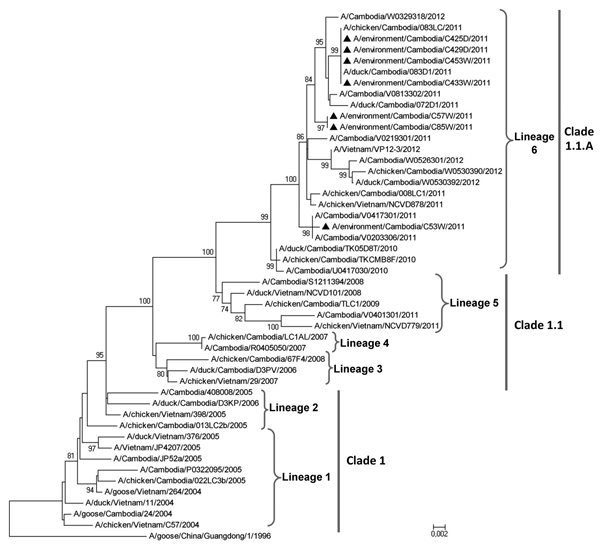Volume 19, Number 2—February 2013
Dispatch
Influenza A(H5N1) Virus Surveillance at Live Poultry Markets, Cambodia, 2011
Figure 2

Figure 2. . Phylogenetic relationship of the hemagglutinin (HA) gene among various influenza A(H5N1) strains; HA sequences for 48 strains (36 from Cambodia, 11 from Vietnam and one from China) were included in the analysis. Black triangles indicate viruses detected during this study of environmental samples from live poultry markets in Cambodia. Phylogenetic trees were generated by using the distance method and applying the neighbor-joining algorithm with bootstrap analysis (1,000 replicates). Analysis was based on nt 1–1,661 of the HA gene. The trees were rooted to A/goose/China/Guangdong/1/96 (H5N1). Numbers above and below branch nodes indicate bootstrap value of >70%. Scale bar represents the number of nucleotide changes per site. Lineage numbers 1–6, clades, and subclades indicate strains that are grouped in closely related phylogenetic lineages, as described (14). All sequences included in the analysis are available in GenBank.
References
- World Health Organization. Cumulative number of confirmed cases of avian influenza A/(H5N1) [cited 2012 Aug 10]. http://www.who.int/influenza/human_animal_interface/H5N1_cumulative_table_archives/en/index.html
- Buchy P, Fourment M, Mardy S, Sorn S, Holl D, Ly S, Molecular epidemiology of clade 1 influenza A viruses (H5N1), Southern Indochina Peninsula, 2004–2007. Emerg Infect Dis. 2009;15:1641–4. DOIPubMedGoogle Scholar
- Gutiérrez RA, Naughtin MJ, Horm SV, San S, Buchy PA. (H5N1) virus evolution in South East Asia. Viruses. 2009;1:335–61. DOIPubMedGoogle Scholar
- Van Kerkhove MD, Vong S, Guitiand J, Holle D, Mangtani P, San S, Poultry movement networks in Cambodia: implications for surveillance and control of highly pathogenic avian influenza (HPAI/H5N1). Vaccine. 2009;27:6345–52. DOIPubMedGoogle Scholar
- Vong S, Ly S, Mardy S, Holl D, Buchy P. Environmental contamination during influenza A virus (H5N1) outbreaks, Cambodia, 2006. Emerg Infect Dis. 2008;14:1303–5. DOIPubMedGoogle Scholar
- Horm SV, Gutiérrez RA, Sorn S, Buchy P. Environment: a potential source of animal and human infection with influenza A(H5N1) virus. Influenza Other Respi Viruses. 2012;6:442–8. DOIPubMedGoogle Scholar
- Fournié G, Guitian J, Desvaux S, Mangtani P, Ly S, Cong VC, Identifying live bird markets with the potential to act as reservoirs of avian influenza A (H5N1) virus: a survey in northern Viet Nam and Cambodia. PLoS ONE. 2012;7:e37986. DOIPubMedGoogle Scholar
- Wan XF, Dong L, Lan Y, Long LP, Xu C, Zou S, Indications that live poultry markets are a major source of human H5N1 influenza virus infection in China. J Virol. 2011;85:13432–8. DOIPubMedGoogle Scholar
- Wang M, Di B, Zhou DH, Zheng BJ, Jing H, Lin YP, Food markets with live birds as source of avian influenza. Emerg Infect Dis. 2006;12:1773–5. DOIPubMedGoogle Scholar
- Indriani R, Samaan G, Gultom A, Loth L, Indryani S, Adjid R, Environmental sampling for avian influenza virus A(H5N1) in live-bird markets, Indonesia. Emerg Infect Dis. 2010;16:1889–95. DOIPubMedGoogle Scholar
- Leung YHC, Zhang LJ, Chow CK, Tsang CL, Ng CF, Wong CK, Poultry drinking water used for avian influenza surveillance. Emerg Infect Dis. 2007;13:1380–2. DOIPubMedGoogle Scholar
- Deboosere N, Horm SV, Delobel A, Gachet J, Buchy P, Vialette M. Viral elution and concentration method for detection of influenza A viruses in mud by real-time RT-PCR. J Virol Methods. 2012;179:148–53. DOIPubMedGoogle Scholar
- Horm SV, Deboosere N, Gutiérrez RA, Vialette M, Buchy P. Direct detection of highly pathogenic avian influenza A/H5N1 virus from mud specimens. J Virol Methods. 2011;176:69–73. DOIPubMedGoogle Scholar
- Sorn S, Sok T, Ly S, Rith S, Tung N, Viari A, Dynamic of H5N1 virus in Cambodia and emergence of a novel endemic sub-clade. Infect Genet Evol. 2012 Jun 7. Epub ahead of print. PubMedGoogle Scholar
1These authors contributed equally to this article.